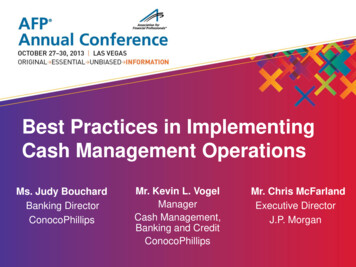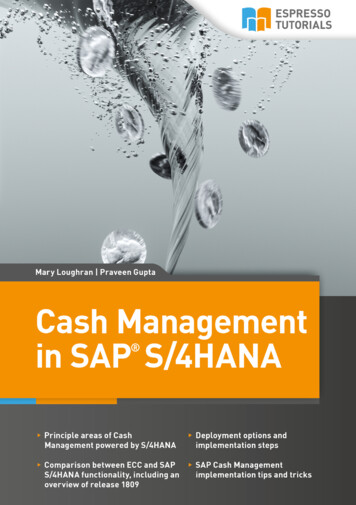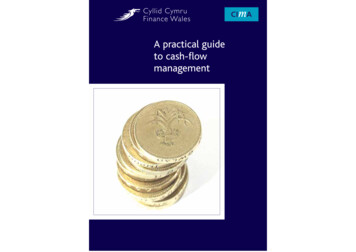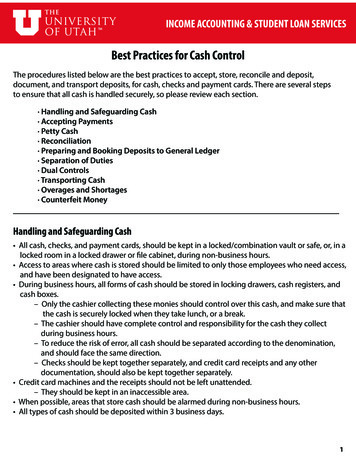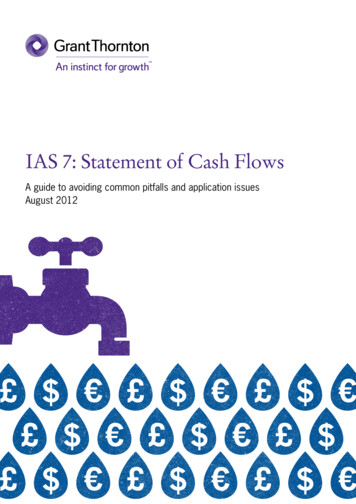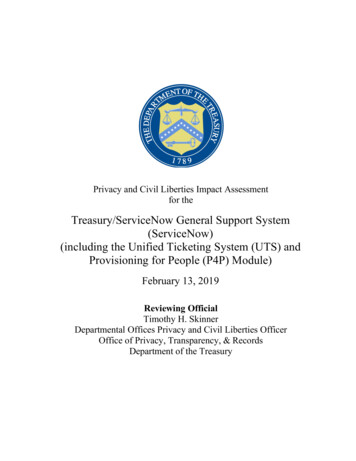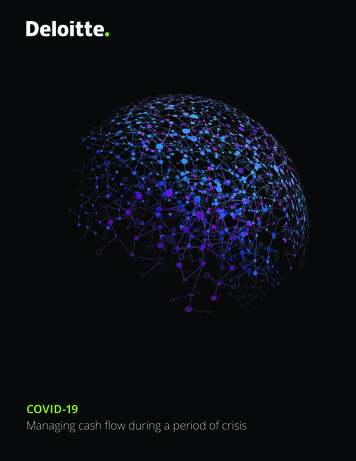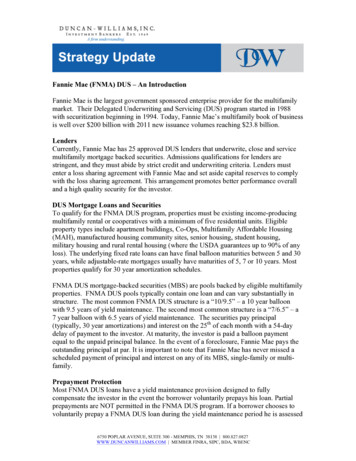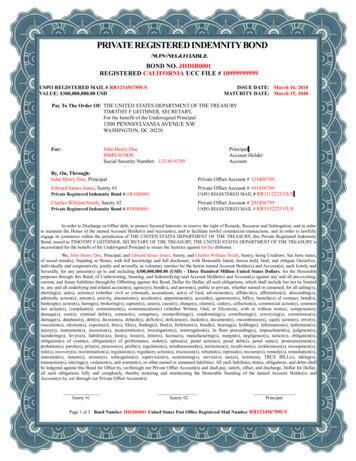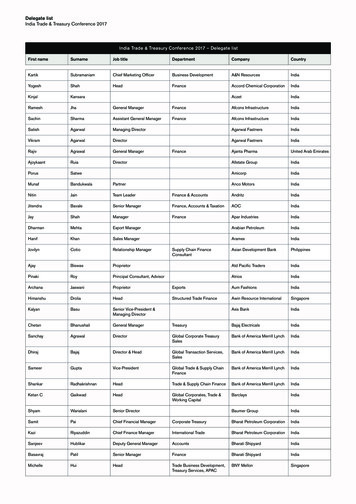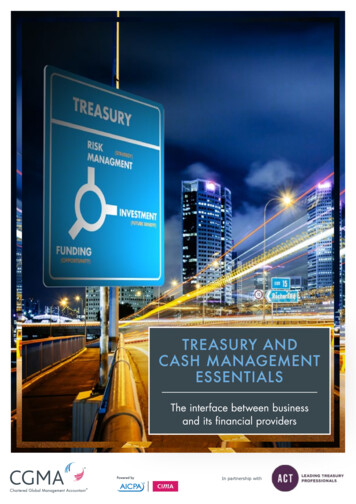
Transcription
In partnership with
THE ASSOCIATION OF INTERNATIONAL CERTIFIEDPROFESSIONAL ACCOUNTANTSThe Association of International Certified Professional Accountants (the Association) is the mostinfluential body of professional accountants, combining the strengths of the American Instituteof CPAs (AICPA) and The Chartered Institute of Management Accountants (CIMA) to poweropportunity, trust and prosperity for people, businesses and economies worldwide. It represents650,000 members and students in public and management accounting and advocates for thepublic interest and business sustainability on current and emerging issues. With broad reach,rigor and resources, the Association advances the reputation, employability and quality of CPAs,CGMAs and accounting and finance professionals globally.TREASURY ESSENTIALSPositioningtreasury andmanagementaccountingTreasuryand sand stakeholderrelationsCash andliquiditymanagementTreasuryoperationsand controlsSystemsTreasury andfinancing ccountingPrinciplesFinancial riskmanagementand riskreportingASSOCIATION OF CORPORATE TREASURERS (ACT)The Association of Corporate Treasurers (ACT) sets the global benchmark for treasuryexcellence. As the chartered body for treasury, it leads the profession through internationallyrecognised qualifications, by defining standards and championing continuing professionaldevelopment. It is the authentic voice of the treasury profession, educating, supportingand leading the treasurers of today and tomorrow.www.treasurers.org
CONTENTSIntroduction2Positioning treasury and management accounting3Treasury and corporate strategy4Business and financial strategy4Corporate funding4Strategic and financial risk management5Financing guidelines and policies5Capital structure6Gearing or leverage6Corporate borrowing7Asset-based finance8Business operations and stakeholder relations9Business operations9Stakeholder relations9Own credit risk11Cash and liquidity management12Cash and liquidity forecasts12Cash management13Working capital management14Treasury operations and controls16Internal controls16Counterparty risk18Systems19Straight-through processing19Treasury management systems19Treasury and financing risks21Interest rate risk21Economic foreign-exchange risk, or strategic foreign-exchange risk23Currency/commodity transaction risk23Foreign-exchange transaction risk24Financial risk management and risk reporting27Risk management approach27Risk management vs speculation28Risk management framework28Risk heat maps31Risk reporting31Governance32Treasury objectives32Treasury policy32Treasury accounting34International Financial Reporting Standards (IFRS)34US GAAP35Conclusion36Further resourcesGlobal Management Accounting Principles3738TREASURY AND CASH MANAGEMENT ESSENTIALS1
2INTRODUCTIONINTRODUCTIONWhether it knows it or not, almost every business of any size ‘does’ treasury: the administrationof its financial assets and holdings with the aim of optimizing liquidity, ensuring the rightinvestments are made and reducing risk.Treasury practices have become significantlymore complex since the global financial crisis. Thelandscape is abounding in uncertainty and risks. Atthe same time, big data and value chain financingare providing new and powerful opportunities toevolve how organizations ‘do’ treasury.The dynamic nature of treasury is challengingthose responsible for it. With its emphasis oncash, risk and markets, treasury differs from otherfinance activities. The complexity of instruments,systems and interactions with the business, bothoperationally and strategically, means that some ofthe skills needed for treasury are specialized.Management accountants who have treasuryresponsibilities are dedicating more time to workingacross financial and non-financial units, leadingthe culture of risk management and developing andchallenging shareholder and economic models.This guide highlights the need for close alignment,understanding and cooperation between themanagement accounting, tax and treasury functionswhen making decisions on investments, fundingand risk strategies.As guardians of organizations’ assets, managementaccountants have responsibility for stewardingliquidity, optimizing capital structures andsupporting the execution of strategies that generatevalue for all stakeholders. Particularly since the2008 global financial crisis the treasury functionof any organization is operating in a much morecomplex environment in which to generate value.Management accountants must update their skillsand competencies to cope with this new norm.2TREASURY AND CASH MANAGEMENT ESSENTIALSThe Global Management Accounting Principlesdeveloped by the AICPA and CIMA underscorethe importance of this stewardship role in both largeand small organizations. The Principles outline theimportance of relationships and communication thatdrives better decision making. They also provideguidance on the process of presenting the insightgained from analyzing relevant information thatis critical to the value creation process.The Global Management Accounting Principlesidentify fourteen practice areas that make acontribution to the process of creating value.While there are interdependencies among allelements of strategy and finance, the key practiceareas that this document expands upon include: Treasury and Cash Management Financial Strategy Investment Appraisal Risk ManagementWritten in partnership with the Association ofCorporate Treasurers (ACT), the chartered bodyfor treasury, and drawing on its technical expertiseand treasury competency framework, this treasuryresource will prove invaluable to managementaccountants who recognize these new challengesand wish to develop the capabilities to takeadvantage of the related opportunities.
POSITIONING TREASURY AND MANAGEMENT ACCOUNTING1. POSITIONING TREASURY ANDMANAGEMENT ACCOUNTINGThe key role of the treasury function is to advise the Board and management on businessdecisions and financial considerations that are fundamental to corporate strategy. Securingfinancing, maintaining funding and managing risks are essential treasury skills that enablethe execution of that strategy.Every organization deals with treasury issues, butmany organizations do not have a distinct treasuryfunction. Treasury may mean a discrete practicewithin an organization or part of the responsibilitiesof a management accounting function. Similarly,the role of Treasurer may be a discrete role ormay be part of the responsibilities of a broaderrole such as Financial Controller or CFO.At the strategic level, treasury is about advising onthe appropriate choices, trade-offs and compromisesinvolved when financial decisions are taken. Threestrategic and interrelated questions are fundamentalto treasury decision making:1. What should we invest in?2. How do we fund these investments?3. How do we manage the risk of our choices?‘Investing’ refers to any use of resources forfuture benefit. It covers not only acquiring property,plant and equipment, M&A and intangible assetslike patents, know-how and brands, but alsoR&D, staff training and marketing programs.Even if not explicitly, management accountantsaddress these questions on a routine basis becausethey are the foundations of business strategydevelopment. Different organizations will havedifferent financing considerations, as there willbe different answers to these three questions.(Naturally, a utility company and a confectionerymanufacturer will have very different responses.)The time horizons they take into account and therisks they need to manage may be different too,whether because of the nature of the business orthe type of financing chosen. It is impossible totake sound decisions about any one of thesequestions without influencing or being affectedby the answers to the other two. In other words,they are interdependent.The answers to all three questions also dependon external factors, often interrelated, whichcan further increase uncertainty. Some strategicchoices that may seem straightforward on thesurface actually conceal unforeseeable consequences.Accordingly, judgment is constantly required –from the outset and as conditions change.TREASURY AND CASH MANAGEMENT ESSENTIALS31
2TREASURY AND CORPORATE STRATEGY2. TREASURY AND CORPORATE STRATEGYBusiness strategy and financial strategy together form corporate strategy. Financial strategydepends on the business strategy – but business strategy is enabled or constrained by thefinancial strategies that are available.Figure 1: Corporate strategyBUSINESS STRATEGYSTRATEGYBUSINESS Business and financial strategyWhat do we invest in, how do we fund thoseinvestments and how do we manage the riskof our choices?These questions are central to the developmentof business strategy and to the financial criteriafor investing. It is essential that the investmentswill earn enough to cover the cost of fundingthem and to compensate for the risks involved.Treasury plays a key role in determining theorganization’s financial strategy, working out howto finance the business strategy and how to managethe risks that follow from this. It sets out what ispossible financially, at what cost and with whatrisks as the business and the environment evolve. Equity is the best shock-absorber, as it placesfew demands on the organization’s various cashflows. Debt funding via a loan involves compulsoryinterest and the eventual repayment of the amountborrowed, either from the business’s cash flowor from new funding raised via debt or equity.Other funding strategies that businesses candeploy include asset-based financing, leasingand working-capital financing.Key questions to consider – Start the dialogIn raising funds, consider: To which types of funding and fundproviders does your organizationhave access?Corporate funding Should additional finance be raised asequity, debt or a combination of the two?An organization needs capital to fund its presentassets, its planned future development (includingan allowance for opportunistic investment) andto absorb the cash-flow effects of responding tounexpected shocks (whether internal or external). Does what is being invested in lend itselfto asset-based finance in other words;could it be rented or leased and atwhat cost?There are three primary sources of funding: the useof an organization’s own cash reserves generatedfrom accumulated surpluses; loans; and equity.4TREASURY AND CASH MANAGEMENT ESSENTIALS Are there other existing assets that couldbe financed more easily, releasing fundsfor the new investment?
TREASURY AND CORPORATE STRATEGYStrategic and financial risk managementThe risk management system covers the providers of funds against risks.Key questions to consider – Start the dialog Are the risks from the actual investment acceptable, when compared to the business to whichit contributes? Is the cash-flow impact of servicing and repaying (equity aside) the funding and any associatedconditions (such as covenants and default wording) both acceptable to and manageable by theorganization and those who provide its funding? Is the overall business risk, including the total funding and cash-flow risks, acceptable to andmanageable by the organization and the fund-providers?Getting ahead – The management accountant’s perspectiveManagement accountants should be aware of the range of possible risks and how they might be mitigated inevaluating the financial feasibility of strategic options, covering a range of realistic scenarios. Examples mightinclude risks arising from movements in interest rates, foreign exchange rates, commodity prices and inflation.If, for example, a plan cannot be funded in its current form, the treasury function should suggest modificationsto the plan or phasing it in over a longer period.Some risks will be managed through structural decisions about the business. For example, the location of newplant may affect currency exposures, access to finance or the security of supply for input commodities. Otherfactors, such as sourcing decisions and flexibility in the sourcing of materials, components or finished goods,will also affect how risk is managed.Other risks will not be subject to such structural solutions, but may be addressed through contract negotiation.For example, the pricing formulae in contracts may permit adjustments for changes in interest rates, exchangerates or commodity prices. Other risks will be accepted, monitored and managed.Financing guidelines and policiesOverall guidelines for financing and for managingfinancial risk are derived from the financial strategy.These then set the approach to funding, managingcurrency and interest rate risks, investing surplusfunds, setting counterparty limits and more. Suchguidelines therefore ultimately enable the creationof treasury policies.Key questions to consider – Start the dialog Are your financial strategies integratedwith your business strategy? Are your treasury objectives clearlydefined and aligned with yourorganization’s objectives? Do your treasury policies accuratelyreflect those objectives and addressany risks to reaching them?TREASURY AND CASH MANAGEMENT ESSENTIALS52
3CAPITAL STRUCTURE3. CAPITAL STRUCTUREExternally raised capital may be debt or equity, although hybrid structures can also becreated. Capital-structuring theory and market practice provide many techniques foroptimizing an organization’s capital structure.Considerations for some organizations may bethe tax treatment of loan interest, equity dividends,and (under the G20 Base Erosion and Profit Shifting[BEPS] proposals) the amounts and locations of debt.An organization’s financial strategy assesses theoptimal financing solution, based on the followingthree factors:1. Ranking of capital – the ease and cost of financing2. Leverage – how to measure and monitor leverage3. Markets – the diversity of sources and theAs shown in Figure 2, the overall cost of funding –the weighted average cost of capital – increaseswith higher gearing (as well as with the riskinessof the business strategy). At some point, investorsare likely to become concerned about returnof capital (not return on capital): in such cases,new funds are refused whatever the priceoffered. In squeezes and panics, such a refusalmay arise at much lower gearing levels, leavingsome organizations that were previouslyfinanceable now incapable of finding finance.maturity of financing.Gearing or leverageThe proportion of total capital that is debt is called‘gearing’ or ‘leverage’. The optimum level dependson the organization’s risk and return dynamics.Higher levels of debt increase the required returnon equity (the cost of equity to the organization),which is classically offset by the increasedamount of the relatively cheaper debt.By maintaining a gearing or credit-rating target, anorganization is able to position its creditworthinessin the funding markets, optimizing sources, pricingand terms for funding.Figure 2: Gearing levels(Curves are intended to illustrate the concept and do not represent costs for any particular company)Cost of capitalSqueeze or panicCost of capitalOptimal gearingSome firms thatwould have beenfunded will now fail“Refusal”Little equity,mostly debtLittle equity,mostly debtGearingAfter-tax cost of debt6Cost of equityWACCTREASURY AND CASH MANAGEMENT ESSENTIALSGearingAfter-tax cost of debtCost of equityWACC
CAPITAL STRUCTUREFigure 3: The effects of gearing/leverageUngeared returns fromthe business.(After business tax.)Return on Assets12.8%Geared costof capital forAA-rated firm(After business tax.)Debt30%Equity70%Cost4.0%Return16.6%Ungeared returns fromthe business.(After business tax.)Return on Assets12.8%Geared costof capital forB-rated firm(After business tax.)Debt70%Equity30%Cost8.0%Return24.0%If the return on assets is unchanged, businesses might find the effects shown above when movingfrom stronger credit (less debt) to weaker credit (more debt).Corporate borrowingRiskier businesses or those with shorter-lived assets will tend to rely more on equity and onlyborrow over the short term if at all (perhaps for a quarter or a year).Organizations with more stable cash flows andlonger-term assets will be more comfortableservicing debt and so are likely to borrow forproportionately longer periods. For example, abuilding may be 65% debt-financed, out to 30years, with the (supposedly) reliable rental incomeservicing both the debt and equity.Some loss of control by shareholders can be anon-cash cost of debt. This is because covenantsin lending contracts can cause constraints meaningthat lenders can ultimately take control.This loss of control may be too risky for someorganizations, so they choose to avoid debt.Examples include businesses like high-tech,nano-tech or bio-tech companies with high realoption values that are dependent on furtherdevelopment being undertaken by hardto-find experts.Other organizations deliberately choose a highgearing strategy, such as the use of structuredfinance, hybrid instruments, project financeor private-equity deals.The availability of funding cannot always be reliedupon, as banks’ risk appetites vary depending onmarket conditions. This can impact the industries,credit standings and even the geographical regionsto which banks are willing to lend. Organizationswill therefore need to plan the raising of new fundswell ahead of when they need them, to diversifytheir sources of funding and to ‘warm up’ potentialinvestors and lenders in advance. Few organizationsthat have the ability to choose would leave therefinancing of significant committed outlays ordebt maturities to the final 18 months beforethe requirement crystallizes.TREASURY AND CASH MANAGEMENT ESSENTIALS73
3CAPITAL STRUCTURETable 1: Main funding types and their characteristicsFactorEquityBondsLoans/ Bank DebtReturn on fundsNo obligationto return funds.Bonds must be repaid on maturity.Bank debt must be repaidupon maturity.Relative costHigh InformationdisclosureNone CovenantrequirementsNone Flexibilityof usagePoor LowFixed interest rate. Low Almost always at a floating rate.Investment-grade bonds havefewer conditions and generallyno financial covenants, unlikeloans/bank debtSub-investment grade (‘high yield’)bonds involve more covenants. More private than equity andbonds, but the amount ofrequired information is high,often including business plans.Investment grade bonds havefewer conditions and generally nofinancial covenants compared toloans/bank debtSub-investment grade (‘high yield’)bonds have more covenants. More covenants and moreonerous even for investmentgrade borrowersIt is easier and cheaper todiscuss amendments with banksthan with possibly unknownbond holders.Fairly poor. Asset-based financeSome assets lend themselves to dedicated finance,often called ‘asset-based finance’, while some itemscan be leased instead of owned. Some assets, suchas land and buildings or expensive equipment, aregood security for a provider of acquisition funds.On the working capital front, supplier-led invoicediscounting or factoring (the sale of receivables)and ‘supply-chain finance’ (where the buyer leadsthe process) can all be useful. But it must be notedthat the more asset-based finance an organizationuses, the less asset value remains to support credittaken from other lenders, trade creditors andemployees for unpaid salaries. This can changethe attitude of those creditors.8TREASURY AND CASH MANAGEMENT ESSENTIALS GoodAn amount can often be drawnand repaid at will in revolvingfacilities, unlike in a term loan.An old saying, ‘fund early and fund long’, remainstrue. Organizations need to work harder than ever ontheir funding relationships – not just bank relationships,but all the increasingly diverse potential sources offunding, including private placement debt, directlending and asset-based finance. Funding plans needto explore all options and use creative thinking.Alternatives such as crowdfunding (equity), peer-topeer lending (debt) and specialist FinTech serviceproviders are increasingly credible sourcesof financial solutions for businesses.
BUSINESS OPERATIONS AND STAKEHOLDER RELATIONS4. BUSINESS OPERATIONSAND STAKEHOLDER RELATIONSEffective treasury requires a thorough understanding of the organization’s business modeland its industry. Developing strong relationships with internal and external stakeholdersalike builds credibility and trust in treasury and financing operations.Business operationsThe level and nature of business risks and theirimpact on cash flows have a material impact onkey treasury activities such as managing capitalstructure, funding and liquidity and financial risks.It is important that those responsible for treasurythoroughly understand the business model andthe industry sector within which the organizationoperates, while supporting and enabling theorganization’s business operations and strategy.Management accountants responsible for treasuryactivities must stay close to operational managementto ensure they understand their view and demonstratethat the interdependency of business strategy andfinancial strategy is acknowledged by both parties.For example, whenever an organization issues atender or price list with foreign currency contentand/or with foreign currency costs in the supplychain, the treasurer should understand the risksinvolved. By working closely with the procurementfunction, the treasurer can facilitate the debateon whether to procure from one country overanother. When a new project or investment is beingconsidered, the treasurer can also give guidanceon financing rates, discount rates, entity structuring,cash investment and repatriation, sources andstructuring of finance and their impact on thecompany’s credit rating.Equally, when the treasurer talks to lenders in thecapital markets, understanding both their own sectorand that of their lenders is crucial. They should knowhow each organization compares to its peers as wellas to the wider market for risk and return. Forexample, organizations with high business risk areless likely to take significant financial risks. On theother hand, stable organizations with high-qualityearnings may take more financial risks.Stakeholder relationsWhether it has a dedicated treasury function ornot, every business ‘does’ treasury – often withoutrealizing it. Treasury interfaces with a rangeof business stakeholders, and it is vital that themanagement accounting, tax and treasury functionsare all properly aligned and mutually supportive.Treasury is a specialist practice that focuses on thesecurity of funding, the liquidity of the businessand the yield from investments; as such, it is vitalto effective and trustworthy management accounting.To do its job effectively, treasury (however it isstructured) relies on building credibility and trust,both throughout the business and externally.TREASURY AND CASH MANAGEMENT ESSENTIALS94
4BUSINESS OPERATIONS AND STAKEHOLDER RELATIONSFigure 4: Treasury relationshipsExternalrelationships Organizationalrelationships Finance functionrelationships Management accountants responsible for treasurywill have relationships at all levels in the business,from the CFO, Board members and (in larger orlisted companies) Board Committees such asAudit and Risk Management, downwards throughdivisional management to the line staff runningday-to-day operations and processes. Across otherbusiness functions, strong relationships are formedwith tax, commercial, legal and other supportfunctions as well as those running pension oremployee-benefit schemes.Externally, treasury professionals articulate theorganization’s credit strength and its strategy andmodel for value creation. They also ensure that thebusiness is at all times provided with the financialproducts and services it needs, from high-qualitysources and at an appropriate post-tax cost.10TREASURY AND CASH MANAGEMENT ESSENTIALSRegulatorsOwners, lenders and credit agenciesFinance, accounting and systems providers.HRITM&ABusiness units.CFO/Board and Board CommitteesManagement accountingTax and FP&A.Typical external relationships include not onlylenders and potential lenders, but also publishersof credit ratings, external accounting, tax and otheradvisers, systems and information providers, insurers,employee-benefits providers, government agenciesand auditors. Since the 2008 global financial crisis,regulation, market forces and technology have beenamong the factors which have driven fundamentaland far-reaching changes in the provision of finance.For this reason, external relationships are everybit as important as internal ones.
BUSINESS OPERATIONS AND STAKEHOLDER RELATIONSOwn credit riskPresenting and explaining your own organization’scredit standing to external parties will influencetheir willingness to do business with you andthe terms they will demand. This applies to yoursuppliers, your lenders and lessors alike. Evenyour clients and customers will want to assess thelikelihood that you will still be in business to honoryour commitments in the months and years ahead.Larger organizations that issue publicly tradedbonds may have a formal credit rating frominternational credit-rating agencies. Almost allorganizations will find they have at some pointbeen assessed by a credit-reference agency, anorganization that performs a fairly mechanizedanalysis of publicly available information suchas annual accounts, invoice-payment historiesand court orders.4Credit analysis will start with an organization’shistorical performance, supplemented with forecasts,projections and perhaps an audit of assets.Analysts typically consider the quality of anorganization’s senior management, the credibilityof their strategy and its financial flexibilitywhen developing their forecasts.The business plan and cash flow should bestress-tested in a variety of scenarios todemonstrate the business’s compliance with loancovenants, re-financing abilities and other limitingfactors. Credit analysts focus on how the organizationcontrols potential downside risks. They areless interested in outperformance on the upside,which is more the domain of equity analysts.Getting ahead – The management accountant’s perspectiveManagers need to understand how their organization appears to a lender, including not only their credit profilebut also the economic business case where lending is part of a wider relationship. Management accountantsshould actively manage the credit standing of their organization and routinely report it in their managementinformation. The initiatives, activities and processes that drive the organization’s credit standing should form thebasis of the ‘narrative’ that explains how the credit standing is achieved and how the business plans to sustain orimprove it. This narrative might include the ratings agencies involved, the relationship-management initiatives andprocesses that are in place with them and the factors that they assess.Tool: Credit AgenciesTREASURY AND CASH MANAGEMENT ESSENTIALS11
5CASH AND LIQUIDITY MANAGEMENT5. CASH AND LIQUIDITY MANAGEMENTLiquidity is access to cash. Its management is the most fundamental element of treasurymanagement — if it fails, the organization cannot continue to function.Cash and liquidity forecastsLiquidity enables an organization to do two things:to pay its obligations where and when they fall due;and to source additional funds to meet further obligations.Successful liquidity management therefore depends onhaving an insight into the business’s future cash-generationor absorption – a cash forecast. Cash forecasts arefundamental to a liquidity strategy, with the treasurer oftenlooking ahead over several timeframes to manage liquidity.Liquidity risk can be analyzed by time frame: Operational liquidity risk focuses on short-termneeds arising from day-to-day operations Strategic liquidity risk focuses on longer-term risksand the need to ensure that the businesscan continue and can support changing businessplans in the future.Day-to-day cash forecasts are usually driven by receiptsand payments data from the accounts receivable andpayable ledgers, interest and tax information, and netprofit/performance reporting. They generally cover theperiod from the day they are created until up to 30 dayslater. While treasurers in highly geared or volatilebusinesses often value them greatly, some of their peers incash-rich or cash-generative businesses do not use shortterm forecasts at all. However, the need to optimize theinvestment of surplus cash means more companies arerequiring them today than in the past.Medium-term forecasts often extend to a ‘rolling’ year.They allow the planning of ‘big ticket’ items such as capitalexpenditure, tax and dividend payments and fundingmaturities. They feed into some aspects of forecastingcompliance with financial covenants. These forecasts arebased on stress-tested business plans and only attaincredibility when supported by realistic targets forperformance measures such as surplus, working capitalefficiency (e.g. debtor days, creditor days andstock turnover), asset utilization, tax settlementsand dividend projections.It is vital that management accountants work withtreasurers to ensure that plans are ‘bankable’ – that12TREASURY AND CASH MANAGEMENT ESSENTIALStreasurers are confident of being able to secure theliquidity of the organization.Long-term forecasts are an essential tool for identifyingtrends and overall cash generation or consumption overtime. They are usually driven from plan data prepared bymanagement accountants, and their timescales willtypically extend from one year up to three, five oreven ten years or more.In many organizations, cash forecasting is not performedwell. The forecasts are often too long, too short, not used orconsistently inaccurate. From a practical perspective, thetreasurer should monitor their accuracy by comparingactual data to forecasts, and then give constructive
Treasury and Cash Management Financial Strategy Investment Appraisal Risk Management Written in partnership with the Association of Corporate Treasurers (ACT), the chartered body for treasury, and drawing on its technical expertise and treasury competency framework, this treasury reso
